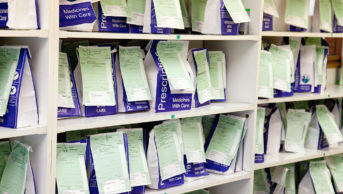
Shutterstock.com
Pharmacists and pharmacy owners hoped for a better future and worked hard to get their messages across to the powers that be during their consultation on the ‘NHS long-term plan’, between August and September 2018.
Local Pharmaceutical Committees (LPCs) and national pharmacy bodies responded to this consultation with enthusiasm, imagination and energy. The signs were hopeful. In January 2019, GPs had their five-year funding plan announced first, and they were granted a £3.5bn per year increase for primary and community care by 2023/2024, on top of the £2.4bn per year by 2020/2021 promised in the ‘GP forward view’, which was first published in April 2016.
Despite health secretary Matt Hancock’s promise in the foreword for the new ‘Community pharmacy contractual framework: 2019–2024’ that this new funding settlement represented a “clear future vision” for the sector[1]
, when I — and other community pharmacists — looked at the detail of this future, we saw that it is surrounded by very dark clouds.
The community pharmacy sector has already witnessed sizeable increases in workload and multiple cuts in funding, with the contract sum reduced by 7.4% from 2016/2017 to 2017/2018. Also, during a presentation made by the Pharmaceutical Services Negotiating Committee (PSNC) to the North East London Local Pharmaceutical Committee in September 2019, we heard that there was the risk of “retribution” if the PSNC had walked away from this deal.
However, I am concerned the NHS and the PSNC may have inadvertently scored an own goal. The contract, which will come into force on 1 October 2019, looks much like a device to squeeze the community pharmacy network of resources and force it to provide open-access public services, funded by the pockets of pharmacy owners.
The PSNC has made a lot of noise about securing a five-year agreement, but not much has been said about what exactly is being secured or not secured. It includes a breakdown of how community pharmacy funding may change over the next five years, but it is shrouded in uncertainty and community pharmacists are left with too many questions about how it will affect their finances.
Changes to the contract
The total funding envelope (global sum) remains constant, at £2.59bn over the five years. However, this figure hides funding cuts, expected increases in workload and further changes to the contract.
First, around 10% of the global sum — approximately £258m — is expected to be removed from the contract by 2021/2022; both medicines use reviews and the establishment payment — originally developed to recognise and support smaller pharmacies — are to be abolished[1]
. This equates to a loss of income of up to £11,200 and £15,000, respectively[2]
,[3]
.
The average pharmacy generates a gross profit of £223,448 per year. Optimistically, assuming a net margin of 8% (£17,875), this profit is gone in one fell swoop and an average pharmacy would end up with a net loss of £8,324.
Second, the framework document also says that the level of funding for dispensing “will reduce over the course of the settlement as new technology and transformation is enabled”. And these losses may further increase.
Inflation, with increasing drug prices, will have to be funded by the pharmacy owners
We can also expect diminishing returns from inflation. The percentage change of average earnings in the UK projected by the Office of Budget Responsibility (OBR) reaches +3.2% by 2023 and inflation (according to consumer price index) at around +2% every year for the next five years[4]
. Bank interest rates are also predicted to rise, from 1.1% to 1.5%[4]
. This, in tandem with increasing drug prices, will have to be funded by the pharmacy owners.
Lastly — and crucially — although the contract says that the loss of dispensing income will be recycled to fund further service provision by community pharmacy, there are no guarantees on the profitability of these new services. To claim back the loss of the net profit of £26,200, pharmacies will have to provide a whole host of new services at an as-yet undisclosed remuneration rate, at an undisclosed margin, with undisclosed training requirements, and an undisclosed estimate of time required to provide the additional services.
An illustrative example is the much-heralded Clinical pharmacist consultation service (CPCS), which will launch on 29 October 2019. This scheme will direct referrals for urgent care patients from NHS 111, GP practices and A&E departments to community pharmacies, with each 20-minute intervention costed at £14.
To make back the £26,200 in lost revenue, pharmacists will need to carry out 1,871 additional CPCS consulations, equating to a total of around 624 hours per year. This breaks down to more than six consultations each day, together totalling just over two hours.
For high-volume pharmacies, supervision rules will make it difficult for the pharmacist on duty to provide these additional services. And, for low-volume pharmacies, even though a pharmacist might be able to schedule some extra time, stress levels will increase. Juggling supervision of dispensing and the provision of six unscheduled 20-minute CPCS consultations per day would challenge even the most organised pharmacist. The referrals are not even guaranteed, either — one pharmacy contractor in London informed me that he currently gets one referral every three months.
Incentivising pharmacists
Providing many of the new services detailed in the contract would require an increase in the operating cost, even if it is marginal. However, what is the estimated gross profit margin for the services? If there is no net margin for the provision of services, what is the reward for the pharmacy owner and the point of providing the additional service, other than reducing the GP burden? If there is a net margin, is it adequate to attract an investment from pharmacies?
We are caught in a spiral in which we are worried about our jobs, our pharmacies, or our savings
Community pharmacists are scared. We are caught in a spiral in which we are worried about our jobs, our pharmacies, or our savings. This fear and an inadequate amount of digestible information about the future makes it impossible to concentrate on anything but saving our skin.
Fear prompts retreat — it is the antipode to progress. Just when we need new ideas most, with this uncertainty, community pharmacy will retrench and perhaps fail to deliver the agreed new services in the contract.
If there is a genuine desire for community pharmacy to deliver these clinical services, we need an agreement to create capacity and increase the capability of the pharmacists through an agreed workforce plan. If the Department of Health and Social Care wants loosen the law around supervision to allow these extra services to be carried out, we should discuss a way forward and consult pharmacists on how this can be achieved.
If the end goal is to close more pharmacies, a number should be agreed followed by a civilised and respectful closures process, rather than inflicting pain on owners during a random cull through financial attrition.
This new contract may have the unintended effect of failing to grow pharmacy-based services, failing the public and providing community pharmacy’s critics an excuse for excluding it from the ongoing transformation of the health service. There is a way forward to deliver a step-change in community pharmacy, but we are far from the clear-sighted vision that the secretary of state says he wants for the sector.
Hemant Patel, secretary, North East London London Local Pharmaceutical Committee; member, Royal Pharmaceutical Society English Pharmacy Board
References
[1] Department of Health and Social Care. Available at: https://www.gov.uk/government/publications/community-pharmacy-contractual-framework-2019-to-2024 (accessed September 2019)
[2] NHS Business Services Authority. 2016. Available at: https://contactcentreservices.nhsbsa.nhs.uk/selfnhsukokb/AskUs_PS/en-gb/7695/mur/17488/information-on-medicine-use-reviews-mur (accessed September 2019)
[3] NHS Business Services Authority. 2018. Available at: https://contactcentreservices.nhsbsa.nhs.uk/selfnhsukokb/AskUs_PS/en-gb/7709/practice-and-establishment-payments/17501/how-is-my-pharmacy-s-establishment-payment-calculated (accessed September 2019)
[4] Office for Budget Responsibility. 2016. Available at: https://obr.uk/forecasts-in-depth/the-economy-forecast/ (accessed September 2019)


